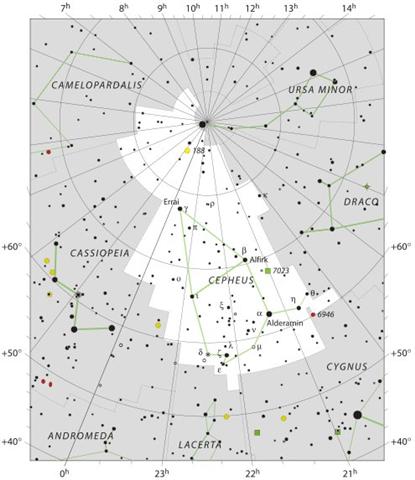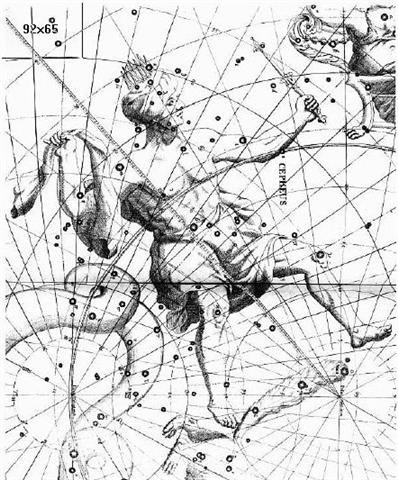2. We have noted the possibility of King Cepheus (high up in Ethiopia), the father of Andromeda, being positioned at glyph number 359 (counted from Gb8-30). The present right ascenion of γ Cephei, which we can identify with the 'head' of this constellation, can be translated to day number 359:
Alrai is not the brightest star in Cepheus, and the reason it was chosen by me as a representative of day (glyph) number 359 (without adding 64) was its declination. We ought to find 'the head of the water for the Nile'.
In Egypt there was a short extra 13th month beyond which their Season of Inundation began: ... The Season of Inundation ... begins after the 5- or 6-day intercalary 13th month, known as Pi Kogi Enavot ... also known as El Nasii... [it] is the thirteenth and last month of the Coptic calendar. It lies between September 6 and September 10 of the Gregorian calendar ... In other words, the end of their year 'of light' ('ebb') came at the end of the extra 13th month and then water ('flood') covered the earth. Rima aueue in location 359 ends with a hipu sign:
There are 24 days (glyphs) from manu rere in Gb4-15 to tagata in Gb5-6. Ordinal number 400 at manu rere is counted from Rogo in Gb6-26, but ordinal number 360 at tagata in Gb5-6 is counted from puo in Gb8-30. Possibly there is a kind of play with numbers and glyphs here, because 400 - 64 = 336 = 272 + 64:
Hipu signs are probably meant to depict waterfilled containers, i.e. indicate a season of rain.
Although the constellation Cepheus like all images in the sky certainly has changed its appearance over the ages we ought anyhow to look at its modern extension:
Here we can see another, and obviously more important characteristic of γ (Errai = Alrai) than the feature of being far in the north, viz. the fact that it is very close to 'time zero'. Sirrah is another name for Ptolemy's 'the head of the woman in chains' (Al Rās al Mar'ah al Musalsalah). This 'head' is not the star with the highest declination in Andromeda and we could therefore come to believe that 'head' indicates the brightest (α) among the stars in a constellation. However, I think 'head' here refers to the position of Sirrah, close to 'time zero'. The connection between Alrai and Sirrah is that one of them (the father) is at the end of the year and the other (the daughter) is at the beginning of the year. Alrai is 'inside the Great Mountain', while Sirrah has been released from its 'cave'. Maybe the picture below has King Cepheus carrying a waterfilled sack in his right hand, just above the upper of the pair of holes formed by the serpentine body of Draco:
In this picture right ascension increases to the right, a mirror image of the normal star chart disposition. But if we are used to reading text from left to right, then it is easier to read also a picture from left to right (i.e. according to the flow of time). The holes formed by the serpent body arrive earlier than King Cepheus. |
|||||||||||||||||||||||||||||||||||||||||||||||||||||||




